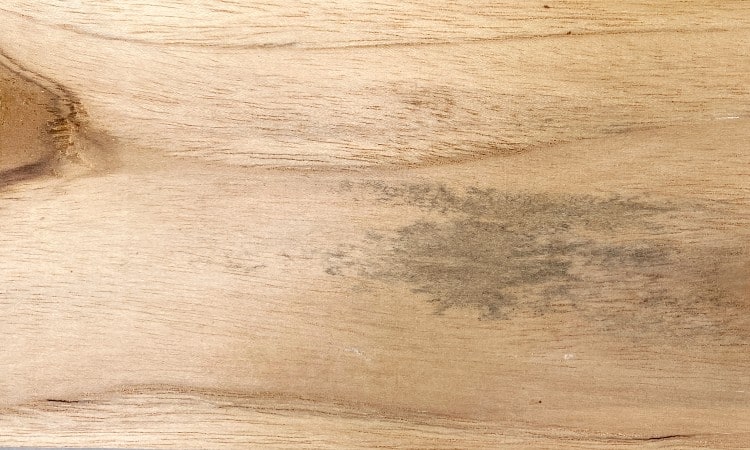The presence of mold on wood can raise major health concerns, making you feel terrified for the safety of everyone in the home. Luckily, there are multiple ways to remove mold from wood.
The best way to remove mold from wood will depend on the type of mold – there are three types common in the home. Common methods include treating the mold patch with vinegar, liquid dish detergent, baking soda, or sanding. Of course, you always need to wear protective gear and handle the area carefully.
When the mold extends over more than a 10 square foot surface, it’s best to leave removal to the professionals. Keep reading to learn the process for removing mold from wood, including multiple products that you can use.
Contents (Jump to Topic)
Different Types of Mold
Although there are many different types of mold, three types commonly grow on wood, easily labeled by the mold’s color – green, white, or black. Signs of mold growth include green streaks, white discoloration, or black dots.
The inner fibers of wood make it prone to absorbing water. As a result, not only can water retention make wood swell, splinter, or crack, but it also creates the perfect breeding grounds for the growth of mold.
Black
The most dangerous type of mold is black – Stachybotrys chartarum – although it may also appear greenish on some woods, paper products, or cotton. You’ll find this mold growing in areas that are heavily damp, such as areas exposed to floods or leaks.
As black mold spreads, it releases spores and mycotoxins, which cause numerous severe and minor health problems – headaches, eye irritation, coughing, wheezing, or respiratory problems. In addition, some people may have stronger sensitivity to mold’s presence than others.
When black mold becomes present, it requires immediate treatment. Unfortunately, the longer mold survives, the harder it becomes to get rid of, as it can grow deep roots – especially on porous surfaces.
Green
Green mold is a type common in nature, although it refers to multiple species of mold. You’ll be able to identify this mold due to its soft and fuzzy or powdery texture.
If you’ve ever forgotten about the last slice of bread or fruit or kept leftovers in the fridge for a few weeks too long, you’ve witnessed green mold.
But you can also find this mold sometimes growing in areas of your home that experience water problems, like basements, bathrooms, kitchens, HVAC closets, closets, or laundry rooms.
Green mold can be harmful, but it’s not as risky as the black mold. Three types of green mold are Cladosporium (olive green), aspergillus, or penicillium (bluish-green). Penicillium has antibacterial properties but also produces toxic mycotoxins.
White
The most common type of mold growth is white mold. This type creates dense stringy powdery white patches on a surface that resemble the look of wool.
It grows mostly on organic materials – food, carpet, fabric, and wood. But many fungi classify as (or appear) white but turn to other colored molds later.
Although white mold is considered non-toxic, it does release spores that can be irritants for those with breathing sensitivities. More importantly, white mold can cause wood to rot, leading to the necessary replacement.
How To Remove Mold From Wood
There are multiple removal methods you can attempt to remove mold from wood. Which option you pick depends on numerous factors –
- Species of wood
- Porous or non-porous (stained or painted – non-porous; natural – porous) surface
- Size of the infected area
- Type of mold
Porous surfaces allow mold to weasel down into the wood fibers, while non-porous woods keep the mold growth on the surface.
If the mold spreads over too much of the wood – more than 10 square feet – the removal methods we’ll list might not help eliminate the infection.
You’ll also need to identify the mold type before trying to remove it. For example, when dealing with toxic black mold – Stachybotrys chartarum – it’s better to call an expert. If inhaled, it can cause several health issues, making it essential to remove all spores so the mold won’t come back.
Once you’ve identified that you’re working with a safer mold (green or white), you can use these four steps to treat the outbreak. For step three, we’ll discuss ten cleaning methods you can use, depending on the severity of the mold and the type of wood.
Step 1 – Protective Gear
When working with mold, it’s best to take precautions and don protective gear to keep you safe, both from the mold spores and the cleaning solutions.
First, you’ll want to wear old clothing, so you don’t risk messing up or damaging good clothes. And, you will also need rubber gloves, eye protection such as goggles, and a face mask that covers your nose and mouth.
Step 2 – Vacuum
After dressing out in your protective gear, you’ll need to use a vacuum cleaner to suck up any loose mold spores.
Be sure that your vacuum is using a HEPA filter and dispose of the contents outside in a plastic bag that’s tightly sealed so the mold spores inside can’t escape.
Step 3 – Clean Off Mold
If you’re dealing with a mold outbreak on wood, there are multiple cleaning solutions you can use, from simple mixtures you can make with common household ingredients to treatments with harsh chemicals.
But most of these methods will only work on mold spores growing on the surface level. You can’t use many of these mixtures to treat mold that penetrates down into the wood.
To clean off surface mold, apply the solution mixture to the area and let it soak. Then use a rag or a scrub brush to aggregate the area to loosen and remove the mold presence.
Step 4 – Sand
If mold is still visible after cleaning, your last resort is to sand the surface. You’ll need to use 100-grit sandpaper while being careful not to rub too much of the surrounding area.
Sanding too much off could leave you ending up with an uneven surface with dips and crevices. Once done sanding the mold off, repeat step 2 and use a vacuum to suck up the infected dust.
Removing Mold From Wood: 10 Methods
Here are ten methods for removing mold from wood, from natural methods to solutions that you apply directly to the affected area. The process you choose will depend on the type of mold and the intensity of the infection.
1. Sunlight
The easiest way to treat mold is to bring the structure outdoors for wood surfaces that you can move around, like furniture.
Direct sunlight is an excellent natural deterrent against musty odors and light mold growth since mold thrives in dark areas with high moisture and humidity.
Bring your wood furniture outdoors early in the morning and bring it back inside before sunset. If there are still signs of mold like spores or a musty smell, repeat the process the following day.
It’s a wise idea to check the weather forecast before deciding to put your furniture outside, as you may need two to three full days of clear, sunny weather.
Pro tip: Lightly spray furniture with a solution of distilled white vinegar and water before placing it outside in the morning. The mixture can help kill the mold spores.
2. Dish Detergent
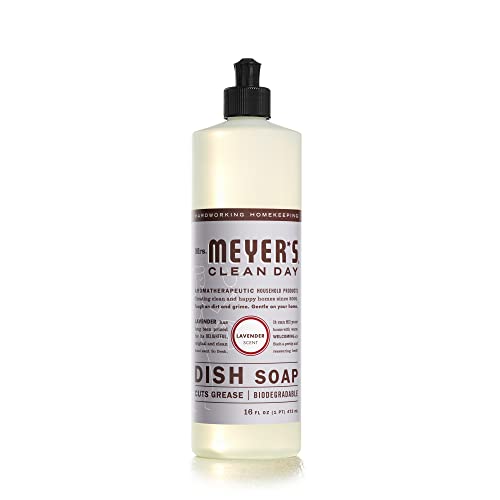 For wood surfaces you can’t bring outdoors for exposure to natural sunlight, the first course of treatment is to make a mixture using dishwashing detergent.
For wood surfaces you can’t bring outdoors for exposure to natural sunlight, the first course of treatment is to make a mixture using dishwashing detergent.
In a spray bottle, combine warm water with one teaspoon of dish detergent. Shake the bottle and then spritz the affected area with the mixture.
Next, use a soft bristle brush to scrub the doused area to break the mold up. Now, use a sponge to blot away excess liquid while scrubbing. Then, wipe the surface with a damp cloth to remove all of the soap solution and debris.
If the mold is gone, you can dry the area with a clean cloth. If the mold is still there, you need to repeat the cleaning process with the dishwashing solution. Or move on to a different method.
3. Distilled White Vinegar
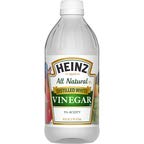 Another cleaning solution you can use for treating mold growing on wood is a mixture of water and distilled white vinegar.
White Vinegar can kill over 82% of mold, making it an excellent treatment choice for light to medium mold growth on the surface.
Another cleaning solution you can use for treating mold growing on wood is a mixture of water and distilled white vinegar.
White Vinegar can kill over 82% of mold, making it an excellent treatment choice for light to medium mold growth on the surface.
You’ll need to combine equal portions of vinegar and warm water in a spray bottle. Then douse the area with the solution and let it soak for one hour.
Next, use a moist cloth to wipe the covered area to rinse the solution free, followed by another towel to dry the area.
Pro tip: Increase the strength of the solution by adding two tablespoons of baking soda and the juice from one squeezed lemon to the vinegar mixture.
4. Sodium Bicarbonate
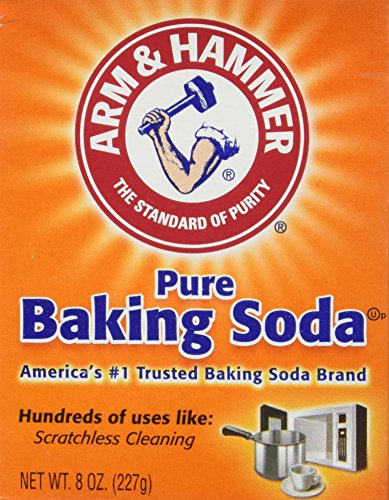 Baking soda – sodium bicarbonate – is a miracle ingredient, versatile enough to work for numerous cleaning solutions, including removing mold from wood. Baking soda can also absorb moisture – preventing mold growth later on – while being safe to use around pets and kids.
Baking soda – sodium bicarbonate – is a miracle ingredient, versatile enough to work for numerous cleaning solutions, including removing mold from wood. Baking soda can also absorb moisture – preventing mold growth later on – while being safe to use around pets and kids.
You have two choices of treatment – creating a spray or keeping the bicarbonate in its powder form for direct application.
Fill a spray bottle with warm water for the liquid form and add in one tablespoon of baking soda. Shake the bottle a few times, so all baking soda dissolves, and then apply the mixture to the moldy area. Finally, use a scrub brush or a rag to clean the area before rinsing and drying the space.
If there are signs of the mold still present, you can apply a second coat and let it dry. This layer will not only kill the leftover mold but also prevent future returns. Finally, finish the cleanse by giving the wood deep conditioning, preserving the timber, and enhancing its natural shine.
You can also create a baking soda paste by leaving the bicarbonate in its granular state. Mix two parts sodium bicarbonate with one part water and vinegar until it forms a thick gook.
Then spread this paste over a moldy horizontal surface and leave it to dry. Finally, scrub the dried paste off the surface before rinsing and drying with separate cloths.
Most cases require that you repeat this removal method two times (or more) to treat all present mold growth.
5. Borax
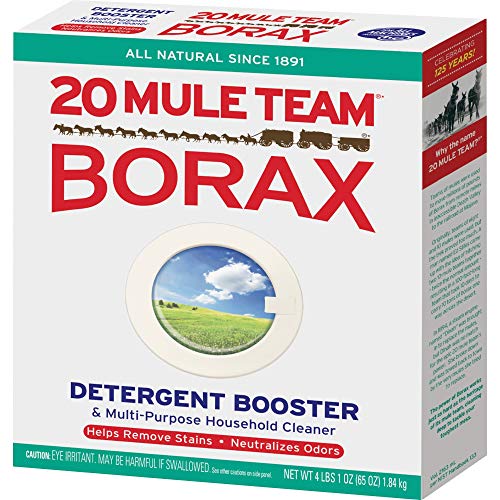 When mold stays present despite cleaners using natural ingredients, it may be time to use commercial chemical products instead.
When mold stays present despite cleaners using natural ingredients, it may be time to use commercial chemical products instead.
Borax – sodium tetraborate – is one of the best chemical treatments for tackling mold. This white alkaline mineral salt powder is safer than bleach, although not as safe as vinegar or baking soda.
You can apply borax as a paste – borax paint – or as a spray. The paste method will kill the mold, but it won’t help remove it from the wood once dead like spray.
Spray
To treat mold on wood with a spray, combine one cup of water with one teaspoon of borax in a spray bottle. Or you can go with a larger quantity of one cup of borax to one gallon of hot water for bigger surfaces like furniture.
Spray the solution onto the affected area, avoiding using a large amount on porous surfaces since they absorb liquid. Then scrub with a sponge, brush, or rag until all the mold is gone.
Paste
Combine a half cup of borax with two quarts of boiling water in a 2-quart (or more) saucepan for a paste. Stir the mixture until dissolved.
Next, use a rag, a paintbrush, or other soft-bristle brush to “paint” over the presence or scrub the cloudy water onto the mold. Then, all that’s left is to let the mixture dry into a white layer on the surface. For faster drying, turn on a fan or a dehumidifier. Or you can place the piece outside to dry in the sun if possible.
There is no need to rinse the surface to remove borax buildup. The presence will prevent mold from returning (as long as you’ve determined the cause and fixed it).
You can even apply a layer of primer or mold-resistant paint right over it. Then use a linen cloth to spread a few drops of linseed oil to the surface once fully dried.
6. Vodka
Vodka can be useful for more than enjoying after-work drinks. When added to a spray bottle and applied to a layer of growing mold, this alcohol can be strong enough to remove mold from wood without damaging the surface.
It’s a fantastic cleaning solution for wood furniture. But that doesn’t mean we’re telling you to use your favorite drinking vodka; the cheapest brand works just fine.
After spraying the moldy wood surface, give it ten minutes to soak. Then use a sponge to scrub the surface until the mold is gone.
If using vodka on furniture, take the piece outdoors to let it dry in the sun. But if you can’t bring it outside, give the room increased ventilation by opening windows or turning on fans.
7. Hydrogen Peroxide
 Hydrogen peroxide is an antibacterial, antiviral, and antifungal that can remove mold from porous wood surfaces.
Hydrogen peroxide is an antibacterial, antiviral, and antifungal that can remove mold from porous wood surfaces.
Combine one cup of warm water with ½ cup of hydrogen peroxide in a bottle for a basic solution. After spraying the mold, let it soak for ten minutes. Then scrub the residue (and the mold) away.
Pro tip: To give your mixture more mold fighting power, add two tablespoons of baking soda, lemon juice, and 100 ml of apple cider vinegar. Let this mixture soak for three to four hours, then wipe the surface with a rag. Be sure the windows are open, or there is some source of ventilation.
8. Mold Armor
 Mold Armor is a fast-acting, powerful commercial chemical used to treat mildew and mold stains and create preventative measures that block the mold from growing back later on.
Mold Armor is a fast-acting, powerful commercial chemical used to treat mildew and mold stains and create preventative measures that block the mold from growing back later on.
And best of all, there’s no scrubbing involved. Instead, spray the mixture on the affected area, give it a few minutes to soak, and then rinse clean.
This product is one that you’ll love having in handy all around the house. In addition to working on wood, Mold Armor can also go on sinks, toilets, shower doors, tubs, grout, and tile, making it excellent for bathroom and some kitchen use.
With products for indoor or exterior surfaces and removing mold stains, mildew stains, or blocking future growth, Mold Armor makes it simple and quick to treat your home for mold. They even have a testing kit so you can identify the type of mold infestation you’ll need to treat.
9. Siamons International – Concrobium Mold Control
 Concrobium Mold Control by Siamons International is another reputable commercial product for treating mold problems indoors or outdoors.
Concrobium Mold Control by Siamons International is another reputable commercial product for treating mold problems indoors or outdoors.
And best of all, Concrobium can work on multiple types of wood, whether it’s OSB, plywood, or wood that’s real or composite, with few minimal-effort steps.
Apply a thin layer of Concrobium to the affected area using a spray bottle (or garden sprayer for outdoors), then let it dry. Then you can use a damp brush or cloth to wipe away the mold residue.
And to prevent future problems, apply a fresh thin layer, which will block the mold from growing back.
This spray is fantastic for decks, outdoor patio furniture, porch swings, and other wood objects at risk of mold growth. But wood is just one of the many types of materials that Concrobium treats.
10. Sporicidin Mold Stain Cleaner
 Sporicidin is a high concentration formula specifically designed for mold remediation and water damage restoration in causes where building materials are impacted. It’s suitable for most surfaces (porous, non-porous, semi-porous), including wood.
Sporicidin is a high concentration formula specifically designed for mold remediation and water damage restoration in causes where building materials are impacted. It’s suitable for most surfaces (porous, non-porous, semi-porous), including wood.
This product contains specialized surfactants with 7.5% hydrogen peroxide, creating a thick cleaning foam that breaks down tough stains caused by mildew, mold, and other microbial.
It also oxidizes organic stains beneath the surface, thoroughly removing all traces of mold. But unlike other products, the foam decomposes into molecules of oxygen and water, leaving zero harmful chemicals behind.
Warning – Avoid Bleach
Do not use bleach to kill mold on wood. Although bleach works on non-porous surfaces, chlorine can’t penetrate the wood. But it can strip the surface, making it look like the mold is gone.
But a few months later, you’ll start to notice mold growth on the surface again – after it’s spread to more of the inside, possibly compromising the structural integrity of the wood.
Best Mold Remover for Wood
If none of the ten methods we listed work for treating your mold problem, you may have to go with a mold remover like these top two products.
EcoClean Solutions Mildew & Algae Remover
 Removing troublesome mildew, mold, and algae can be easier when using Gone – an industrial-strength caustic chemical bleach (stain removal) by EcoClean Solutions.
Removing troublesome mildew, mold, and algae can be easier when using Gone – an industrial-strength caustic chemical bleach (stain removal) by EcoClean Solutions.
This formula battles stains on contact with no need for scrubbing. Instead, you spray it (from bottom to top) and let it soak.
Then rinse with water to see results in a matter of minutes on most surfaces, including wood.
Wet and Forget Mold Remover
 Another stain remover for treating algae, mildew, moss, and mold is by Wet & Forget.
Another stain remover for treating algae, mildew, moss, and mold is by Wet & Forget.
This single-step cleaner also doesn’t require scrubbing, but you also don’t have to power wash or rinse it off.
One treatment keeps outdoor surfaces clean for over one year – non-acidic, non-bleached, and non-caustic. But this product is not for indoor use.
Removing Mold from Wood Furniture
Wood furniture can occasionally experience mold growth when exposed to high moisture indoors or the weather elements outside.
Untreated surfaces can develop mold down into the flesh of the wood, whereas it’s likely only a skin infection with wood that’s painted or stained.
If possible, bring the furniture outdoors and place it in direct sunlight for a full day. You can also clean the wood with dish detergent or white vinegar.
But if these methods don’t work, move on to the other eight removal methods we’ve listed. And finally, try the recommended mold removal commercial products as a last resort. Also, be sure to use a soft brush attachment to vacuum loose mold spores.
Removing Mold from Wood for Floors and Ceilings
If surface mold becomes present on your ceiling or floor, the first step is to determine what source is causing the mold to grow. Next, look for signs of water damage since mold needs moisture to form and spread. After repairing the issue, you can get to work removing the mold from the wood.
Start with removing all the furniture from the space. Then prepare your cleaning solution – a mix of vinegar, water, and dish soap to start. Apply this solution to the moldy area and let it sit for 10 minutes. The ingredients should kill all surface traces and prevent regrowth.
Then, wipe the solution off using a wet cloth. Once the floor is dry, you can put the furniture back in place. And for two to four weeks, keep a close watch to make sure there are no signs of mold returning.
But if the mold penetrates the wood’s innards in the floors or ceilings, you should start with the hydrogen peroxide mixture. After letting the solution soak, scrub the area with a hard bristle brush. Then if that fails, try a commercial cleaning solution or seek out professional help.
Pro tip – Always wear protective gear – a mask and rubber gloves. And use proper ventilation – open windows or turn on fans.
How to Prevent Mold Growth on Wood
Being proactive can help stop the chances of mold growth. However, if mold grows too far into the wood, it can compromise the structural integrity, requiring replacement.
The most effective method of preventing the growth of mold is to keep the wood dry. You also need to control moisture levels and humidity to less than 60% (when possible). And dry all wet areas as soon as possible.
When working with wood indoors, use a dehumidifier to remove moisture from the air. And by frequently opening windows, you’re allowing the room to ventilate and circulate fresh air.
The Difference Between Mold and Mildew
Mildew is the most common type of mold found growing in homes. As an early stage mold, the microscopic fungi start as a surface mold that spreads through the air as spores.
It starts as a gray or white powdery mold that grows on the surface of damp, warm places, like basements, laundry rooms, and shady porches. Then it colonizes and grows to resemble dirt or toxic mold with its black to brown color.
To determine if a spot is mildew or dirt, dab the stain with a cotton swab soaked in bleach. If the stain disappears or lightens within a few minutes, it’s mildew. But if the color stays the same, it’s dirt.
The main difference between mildew and mold is that mildew is a fungus that grows on top of the wood and discolors the surface, while severe types of mold will penetrate down into the wood and damage the wood’s strength and structural integrity.
If the wood becomes soft or crumbly, with slimy or fuzzy green or black mold, it’s signs of irreversible rot, requiring immediate removal and replacement.
Conclusion
There are multiple types – and colors – of mold, with black mold being the most harmful to your breathing and basic body functions. If the mold infestation is only on the surface of the wood, you can clean it yourself using one of our ten removal methods and following our four steps.
But when there is a heavy mold presence over a large area, or if you can smell the mold but can’t find it, or you can’t keep it from coming back, it’s time to reach out to an expert cleaner.
